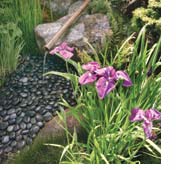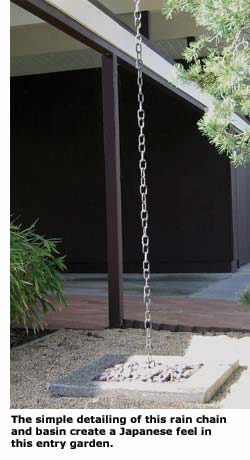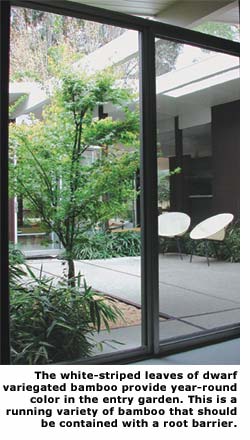Modern Landscaping
 "Whereabouts in Japan do you live?" said the noted modern landscape architect James Rose in response to a client's request for a Japanese-style garden. Rose had spent considerable time in Japan, and this quip was intended to call into question the idea that it was possible to create an authentic Japanese garden outside of the physical and cultural environments of Japan.
"Whereabouts in Japan do you live?" said the noted modern landscape architect James Rose in response to a client's request for a Japanese-style garden. Rose had spent considerable time in Japan, and this quip was intended to call into question the idea that it was possible to create an authentic Japanese garden outside of the physical and cultural environments of Japan.
Rose's comment brings up an important question that confronts those working with the yards and gardens that surround modern homes: How does the modern homeowner work with design elements that have a strong Asian sensibility without overdoing it?

Mid-century modern architecture owes an obvious debt to Asian design principles. This significant influence can be seen in the rectilinear geometries, open floor plans, multifunctional rooms, and the all-important direct connections between the interior of the house and the adjacent garden.
With this in mind, looking for garden design inspiration in the classic landscapes of Japan and Asia makes sense and can yield great results if one keeps in mind three basic principles: simplicity in material selection and detailing, appropriate plant choices, and design restraint.
When making decisions about garden details and materials, the modern homeowner looking to create an Asian or Japanese-inspired garden should keep simplicity in mind. The rain chain and basin at the entry of this Bay area Eichler home (right) is a good example of this point.
During the design of this garden, the homeowner asked if the roof drain located near their front entry might be used as a design feature. The idea of a rain chain and basin was discussed and a number of alternatives were developed. Ultimately the simplest chain style available was selected. The homeowner purchased the chain through an internet supplier and it installed it himself. Typically rain chains hang from a simple clip that fits into the outfall of a standard roof gutter, making them one of the easiest weekend projects.
After rainwater runs down the chain pictured here, it collects in a clean-lined square concrete basin that empties into the landscape drainage system. The color and finish of the poured-in-place concrete basin closely matches the nearby entry path and the paving in the atrium of the house. The chocolate colored stones within the basin were selected because they corresponded to the color of the home. The overall result is an interesting garden detail that provides a subtle Japanese effect near the front entry of the home without making an overtly Oriental statement.

Many plants have obvious cultural and geographic associations. Bananas and palms will always evoke a feeling of the tropics, while pines and alpine plants will bring to mind the mountains. Bamboo, in all of its amazing variety, is a very effective choice for creating a garden with an Asian verve.
The atrium garden of the home discussed earlier (left) features a perimeter planting of dwarf variegated bamboo (Sasa vetchii) and a single Japanese maple (Acer palmatum), another mainstay of the Japanese garden, to create an environment that clearly shows as Asian influence without going as far as stone lanterns or Buddha figures.
The planting design for this garden relies heavily on foliage color and texture rather than flowering plants for interest. The number of different plant species has been kept to a minimum, but the plants that are present have been massed in large groups for impact.
Climate, of course, has a significant impact on plant choices, but the same strategy based on foliage and massing can be applied to a garden in any region. With different plant choices, our Asian-inspired atrium garden could be readily recreated for a sheltered patio in Palm Springs. As a focal point, Japanese Oleander (Rhus lancea) might be substituted for the maple tree. Much more tolerant of high summer temperatures, the lacey foliage and gnarled trunk of this small patio tree have a distinctive character that resembles Bonsai. The bamboo that defines the edge of the atrium patio could be replaced with a variegated variety of snake plant (Sansevieria trifasciata hahnii). By bringing a color highlight to the predominantly green planting plan, this tough shade- and drought-tolerant foliage plant would serve a similar function as the dwarf white striped bamboo.
Design restraint, the third concept, is one of the defining characteristics found in the gardens of James Rose himself. While the influence of traditional Japanese garden design is clearly visible in Rose's work, he never resorted to direct copying of Japanese details. Rather, he translated classic Asian garden design elements into features that complemented the modern architecture of the home.




